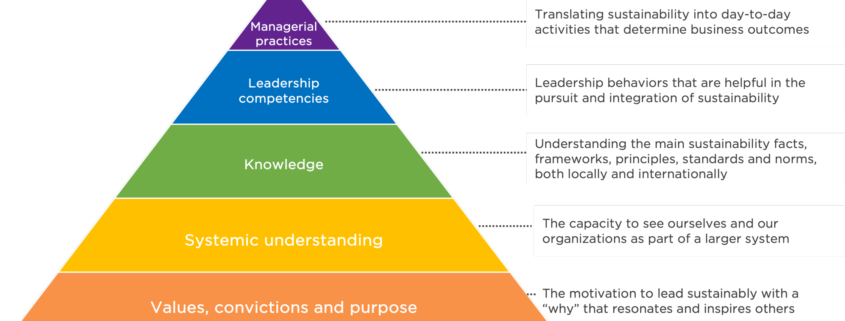Leading sustainability with purpose
“Leading sustainability with purpose” – Part 2 of the Sustainable Leaders’ Series on the Sustainable Leadership Model
By Gabriela Buettner, senior consultant at New Angles, consulting partners of Sustainable Leaders
The fundamental challenge of integrating sustainability into business is that it requires managers at all levels to see the world differently and define success differently. We can’t hope to accelerate the global transition to sustainable business using the same leadership mindset that has single-mindedly pursued rising quarterly profits and limitless growth for decades.
 Against that background, the Sustainable Leadership model offers a new approach of leading the transition towards deeply sustainable business models, products and services. The model consists of 5 different dimensions that build on each other, as well as on existing best practices within organisations.
Against that background, the Sustainable Leadership model offers a new approach of leading the transition towards deeply sustainable business models, products and services. The model consists of 5 different dimensions that build on each other, as well as on existing best practices within organisations.
So, where does the transition journey start? With values, convictions and purpose, the base of the model and the dimension we’ll focus on in this second part of our series about the Sustainable Leadership Model.
VALUES, CONVICTIONS AND PURPOSE
When these three aspects are aligned, as a leader you are coherent, credible and inspire confidence in others – clearly embodying that ‘Why’ which incites people to follow you.
This is also the part of the iceberg that goes the deepest – and also the least visible or tangible, but which remains the foundation for the rest of the dimensions. What do you fundamentally believe in? What are your convictions? Your sense of purpose at work?
Let me highlight a few aspects of this dimension that are essential for a leader of sustainability:
→ The courage to act based on your personal convictions on sustainability. The courage to act based on your desire for a more just society and a healthy environment. Without this, change towards sustainability is not possible. We’ve seen many “positive impact pioneers” in all types of organizations – they exist and are already modeling change wherever they are in the organization.
→ The ability to create a link between past, present, and future generations. The time aspect of sustainability is important and obviously goes far beyond the short-term. The sustainable leader is convinced that we need to see things in a global sense – what we did yesterday, what we’re doing today, and where we want to go tomorrow are all connected. This leader naturally has a deep concern for future generations.
→ Looking for meaning in work. Sustainable leaders need meaning in their work above and beyond “making a living”, and find it in leading their organizations and teams towards sustainable ways of doing business.
→ Stubborn optimism. This is about not giving up, no matter what the obstacles. The sustainable leader knows that there are and will be many, especially when it’s about changing an entire way of thinking that has been in place for years and years.
In our work with companies we see that in parts of the corporate world the basis for sustainable leadership is already recognized and promoted. For instance, in some large multinationals, recruitment is no longer merely based on the CV, but rather on the “who you are” and “what your values are.” Do they match with the values and the vision of the company? Of course, experience and know-how also influence the decision, but it is not what will make the difference in picking one candidate over another.
We invite you to reflect about your own purpose, values and convictions before reading the next parts of the series:
– what do you think managers and business leaders need to do to protect life on Earth?
– what is your personal motivation and conviction on leading sustainably?
– what would you like your professional purpose to be about?
More information
Read Part 1 of the series on the Sustainable Leadership Model




